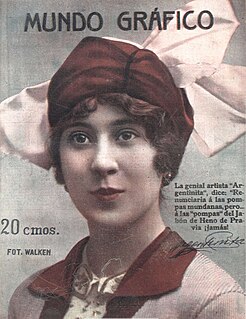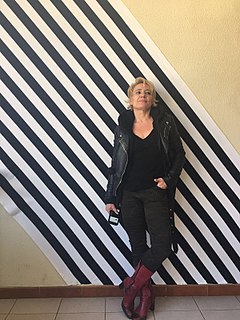
Encarnación López Júlvez, better known as La Argentinita, was a Spanish-Argentine flamenco dancer (bailaora), choreographer and singer together with her sister Pilar López Júlvez. La Argentinita was considered the highest expression of this art form during that time.
El amor brujo is a ballet composed in 1914–15 by Manuel de Falla to a libretto by Gregorio Martínez Sierra. In 1916, Falla arranged a rendition of the work for sextet and small orchestra and the following year he made a concert version, also for small orchestra. Later, he fashioned a piano suite from it and finally, a second ballet version (1925) that features expanded orchestration, elimination of the narration, small cuts and plot changes, and a different order to the numbers.

Eva María Garrido García, known professionally as Eva Yerbabuena, is a Spanish flamenco dancer. She formed her own dance company in 1998 and won Spain's National Dance Award in 2001. She is considered one of flamenco's leading performers.
Danza Contemporanea de Cuba is a contemporary dance company based in Havana, Cuba, combining modern American theatre, Afro-Caribbean dance styles and classical European Ballet.
Rafael Aguilar was an Ecuadorian ballet dancer and choreographer.
Natalia Millán is a Spanish actress.
Nicole Nau is a German dancer of Tango Argentino and Argentine folklore.

Luis Pereyra is a dancer and choreographer of Tango Argentino and Argentinian folklore.

Antonio Salinas is a Mexican dancer, choreographer and stage actor. He has studied and collaborated with Mexican and international artists and has taught in a number of universities at home and abroad. In 1999, he was named one of the best dancers in Mexico by Zona de Danza.
Laleget Danza is an international dance company based in Mexico City which was founded by Diego Vázquez in 2005. It has performed in Spain, Netherlands, Slovakia and Curaçao. It has appeared in various theaters and festivals in Mexico including the Festival Internacional Cervantino in 2008 and 2011.

Javier Antonio García Expósito is a dancer and choreographer. He debuted at the age of sixteen in the National Lyric Company. In 1979, he joined the National Ballet of Spain, as soloist under the direction of Antonio Gades. After receiving an award as the Festival d'Avignon, he founded in 1988 in Cordoba the Ziryab Danza of which he was director, choreographer and dancer. He had considerable success with the show Hijas del Alba. A year later, he received three national awards at the Concurso Nacional de Arte Flamenco. In 1990, he toured with the show La fuerza del destinoall over Europe, and participated as a guest artist with Mario Maya in Diálogos del Amargo. He collaborated on Concierto flamenco para un marinero en tierra with Vicente Amigo before winning the first prize in dance at the Festival del Cante de las Minas in 1994.

María Ruanova was an Argentine dancer, choreographer, teacher and ballet master, known for her performances at the Teatro Colón and internationally. She is considered the first Argentina-grown ballet dancer to gain international fame.

Ch'unchu is a folk dance in Peru. It is performed on festivals of the Cusco Region like Mamacha Carmen in Paucartambo and Quyllur Rit'i. Varieties include q'ara ch'unchu, qhapaq ch'unchu and wayri ch'unchu.
Christa Cowrie is a German-Mexican photographer, who began her career in photojournalism but is best known for her work documenting Mexico’s dance the theater events. Cowrie arrived in Mexico in 1963 and began her career in 1975 with the Excélsior newspaper. In 1977, she was one of the founders of the Unomásuno newspaper, also working to found one its supplements, focusing on ecological journalism. Her work began to shift towards photography dance and theater in the mid 1990s working with the Centro Nacional de las Artes. The archive she has created with this institution is one of the most important in Mexico documenting dance and theater. Her work has been recognized with membership in the Salón de la Plástica Mexicana.
tumàka't Contemporary Dance is a Mexican contemporary dance troupe founded in 2007, under Vania Duran, which works to promote contemporary dance in southern Mexico.
Morena Celarié was a Salvadoran folk dancer. She was born in San Salvador and began her dancing career at a young age. Celarié performed throughout the Western world and founded a folk dancing school in her native country. When cured of paralysis in one of her legs after a promise to the Virgin of Guadalupe, she dressed only in white until her death.

Sol Picó Monllor is a Spanish dancer and choreographer. She has studied Spanish dance, ballet, and contemporary dance, and combines different techniques and languages in her productions in a groundbreaking way. In 1993 she created the Sol Picó Company, with which she has become one of the most heterodox choreographers and dancers of the Spanish contemporary scene. She has received numerous awards, including 10 Premios Max, the National Dance Award of Catalonia (2004), the City of Barcelona Dance Award (2015) and the National Dance Award of Spain (2016).
Sonia Sanoja was a Venezuelan dancer, teacher, choreographer, and poet, a pioneer of her country's dance scene in the 1950s and 60s, particularly in the area of contemporary dance.








